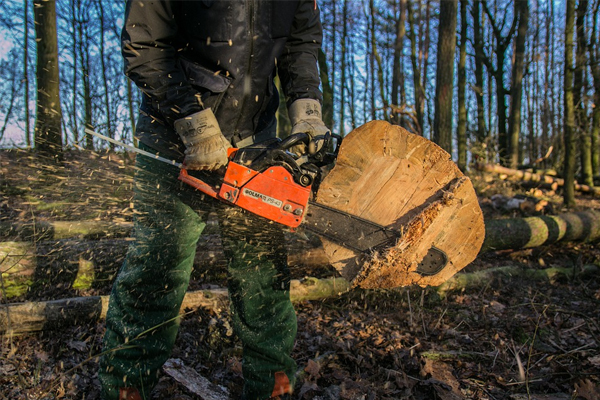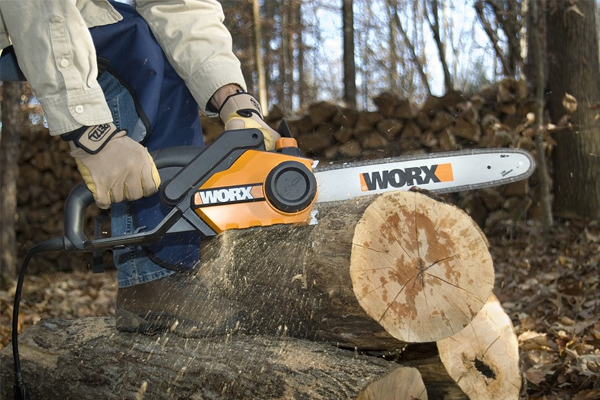
A chainsaw is a valuable tool for homeowners and others who love to keep their yard as appealing as possible. The right size chainsaw can make any pruning hard jobs a snap and cut to reduce logs into manageable sizes efficiently. Several people come up with the question, ‘what size chainsaw do I need to cut down a tree?’ Well, asking this question is valid as the improper size can cause significant issues while cutting and managing the trees.
For instance, a few inches long chainsaw is good, but a larger chainsaw increases the rate of vibration, making it difficult to manage around greater weight. It’s crucial to know and determine the right manageable size chainsaw for your purpose for enabling you to cut or prune efficiently and effectively. This chainsaw size guide has all the necessary insight that you need for this aforementioned topic.

The precise answer to this question depends mainly on the chainsaw bar size. This guide bar or the chainsaw blade is a metallic piece of the bar through which the chain rotates around the saw machine. In addition, there are several factors to consider while choosing the right chainsaw size.
So, let’s take a look at all of them to determine how to choose chainsaw size most efficiently.

The first and foremost thing is determining the type of work for which you need the chainsaw. Suppose you’re some casual domestic user at home who needs the chainsaw for light-duty activities like general pruning at the garden or trimming small branches. In that case, you can go for the less powerful chainsaw, consisting of a shorter bar. This purpose can work efficiently with a chainsaw size of around 14 inches.
If you are looking for chainsaw sizes to perform medium-duty activities such as cutting down small trees, you should pick something around the range of 16 inches to 20 inches. If you want a chainsaw for heavy-duty activities like cutting large trees, you need to choose a chainsaw size around 22 inches or above.
The diameter of the wood that you will most often be cutting stands out as a crucial factor to consider while choosing the right size chainsaw. The standard guideline recommends you choose a chainsaw whose bar is two inches longer than the wood’s diameter that you mostly cut.
For instance, if you need to cut a tree with a diameter of 10 inches, you will need a chainsaw with a bar length of 12 inches. However, you must know that chainsaws can always be used to cut trees with a diameter larger than the bar length. In such cases, you have to cut from both sides, making the diameter cut be doubled for you.
If you’re looking for an easy way out to save time and energy, then a one-way cut-through one pass is a more practical approach. Thus, it’s always best to choose a chainsaw size larger than the tree diameter that you mostly cut around the forest, village, or yard.
Considering your experience in handling chainsaw machines is crucial while choosing the right size chainsaw. This is because chainsaws are one of the most dangerous tools, and using one that is too big, powerful, and heavy to handle for your experience can turn out to be fatal.
So, if you’re a beginner in using a chainsaw, it’s best to start with a small, less powerful light-duty chainsaw. Once you become proficient in using this tool, you can go for the larger ones.
If you’re unable to wield, hold and sustain using a large chainsaw, you can end up having accidental results. This is why the physical strength and endurance of an individual become crucial factors while choosing a chainsaw. You must always select the chainsaw size that you can handle comfortably without losing the endurance power.
It is crucial to determine what type of chainsaw you need to select the correct size. Whether it’s a gas-powered chainsaw, battery-powered chainsaw, or electric chainsaw, you have to choose what you want before moving on to the correct size. All of these types are lighter and manageable, making them ideal for casual users.
When looking for chainsaw sizing, many people tend to buy the biggest one on their budget. You may wonder that the bigger the chainsaw size, the more jobs it can handle, right? Well, that’s not true at all.
Yes, the bigger powerful chainsaw with great bar length may allow you to cut larger trees, but there are a few disadvantages of having these chainsaws too.
The big chainsaws are always heavy and hectic to manage and handle, making it risky and fatal for beginners. If you’re a rookie in using chainsaws, the bigger ones will become fatigued for you. The bigger chainsaw can make your arms tired, resulting in you losing concentration, causing accidents.
Bigger chainsaws are complicated to operate, making them less appropriate for small and detailed work. Moreover, the bigger chainsaws are more expensive than any other chainsaw, so if you purchase the bigger chainsaw that is way bigger than your purpose, you will be making a poor investment.
The best suggestion is to resist the urge to buy a bigger chainsaw unnecessarily unless you are physically strong, experienced with chainsaws, and able to handle them for larger trees.

When choosing a chainsaw with the right blade length, you must consider the nature of your work, its purpose, and the size of the work area. If you’re going for any simpler job like pruning the backyard, a chainsaw incorporated with a saw bar that can cut through a standard tree limb will be adequate.
There are various chainsaw types and sizes. Below you will learn the different types along with their relation to the chainsaw length of the blades.
Electric chainsaws are mostly attached to a power outlet via a length of cord. It is also powered by using a strong battery. An electric chainsaw is the best type for beginners who are new to chainsaws to start to gain practical experience. The standard blade length of this chainsaw type is relatively small, ranging from 8 inches to 12 inches.
Electric chainsaws are ideal for casual home purposes like trimming, limb thinning and pruning. The chainsaw type also makes the ideal choice for cutting down small trees and removing the larger limb. It’s best not to use them for cutting firewood, felling large trees, or storm damage cleanup.
Light-duty chainsaws have always come up as the best choice for beginners looking forward to gaining practical experience using chainsaws efficiently and quickly. The engine displacement of this chainsaw type goes around 30-45 ccs, and the standard blade length goes around 10-14 inch chainsaw.
Like electric chainsaws, these chainsaw types have greater power transmission capabilities, making them an ideal tool for any yard work. Light-duty is adequate for removing smaller trees and larger limbs. Here also, you need to avoid using them for felling large trees, storm damage cleanup, or cutting firewood.
Several users face complications with the use of these two types of chainsaws. It’s best and advisable to use larger chainsaws only if you have years of experience in using chainsaws. If going into the amateur hands, the larger saws can become a tool of destruction and fatality. So, beginners must train them with the small light chainsaws to prepare themselves before handling the larger ones.
The average blade length for medium and heavy-duty chainsaws ranges from 14 to 18 inches. The engine displacement for this chainsaw type is about 40-50 cc.
Heavy-duty chainsaws are the ideal choice for heavy yard or forest work, but in several cases, they result in overkill while hindering your small jobs. The big chainsaws are suitable for working on storm damage, bucking medium-sized tree trunks for removal, and cutting large limbs.
Chainsaws infused with long blade lengths (18-20 inches) are the workhorse best reserved for cutting firewood or felling large trees.
If you're someone whose daily work routine involves using a chainsaw tool, then professional chainsaws are the ideal choice. This chainsaw type is the best choice for those who make a living out of chainsaw usage.
The professional chainsaw comes with an engine displacement that ranges from 60 ccs to 120 ccs. Property owners mostly use this chainsaw type to meet their demands of continuous heavy work or cutting jobs in a large estate area.

The task of woodcutting needs precision and accuracy to meet the safest cutting with the help of a specific chainsaw blade length. Below is a list of recommended chain sizes for various types of job that requires saw cutting.
Pruning Limbs: 6-10 inch chainsaw chain
If you mainly want a chainsaw for your home use, like pruning your limbs, small branches, or trees with thin branches, then a 6-10 inch chainsaw is the ideal tool for the job. However, if you find the branches too thin or thick than usual, you can work with a smaller hand saw.
Removing Branches: 8-12 inch chainsaw
If you want to remove the branches of the larger trees at your home, you will find the branches to be 6-10 inches thick. So, you must use a chainsaw whose guide bar is at least 8-12 inches long for quick, efficient, and effortless tasks at home.
Felling Small Trees At The Yard Or Garden: 12-14 inch chainsaw
You will find small trees in your garden or yard. Depending on their trunk’s thickness, it’s best to always use a chainsaw of about 12-14 inches.
The standard chainsaw size for cutting firewood is 14-16 inches. This size will do the trick when splitting logs into the firewood unless it’s too large.
Farmers usually have to cut or fell down medium-sized trees in the area where they plan to cultivate. For this reason, they need about 16 to 18-inch chainsaws to cut down trees with a trunk thickness of about 14-16 inches on one easy pass.
Arborists are professionals who cut down large trees in national parks and other crucial places. These professionals require heavy-duty chainsaws the size of 20 inches or above. They have experience and qualifications in using chainsaws most efficiently and safely. The guide bar for their chainsaw ranges at least 20 inches.
For milling, industries use professionals to cut down large pine trees and other large trees with the help of advanced professional chainsaws. The recommended chainsaw sizes for millers exceed the size of 20 inches.
By now, you must have known that the correct size chainsaw that you need depends on the job at hand or your purpose. If you have to cut smaller branches, you will need a smaller chainsaw, and if you’ve to cut down large thick trees, you will need a larger chainsaw.
The basic thing that you must remember is whatever may be the thickness of the branch or tree you cut most often, the size of your chainsaw should always be two inches more than it.
So, I hope this article has given you all the information you were looking for about the right size chainsaw you need.